1998 VOLVO V90 wheel
[x] Cancel search: wheelPage 88 of 175
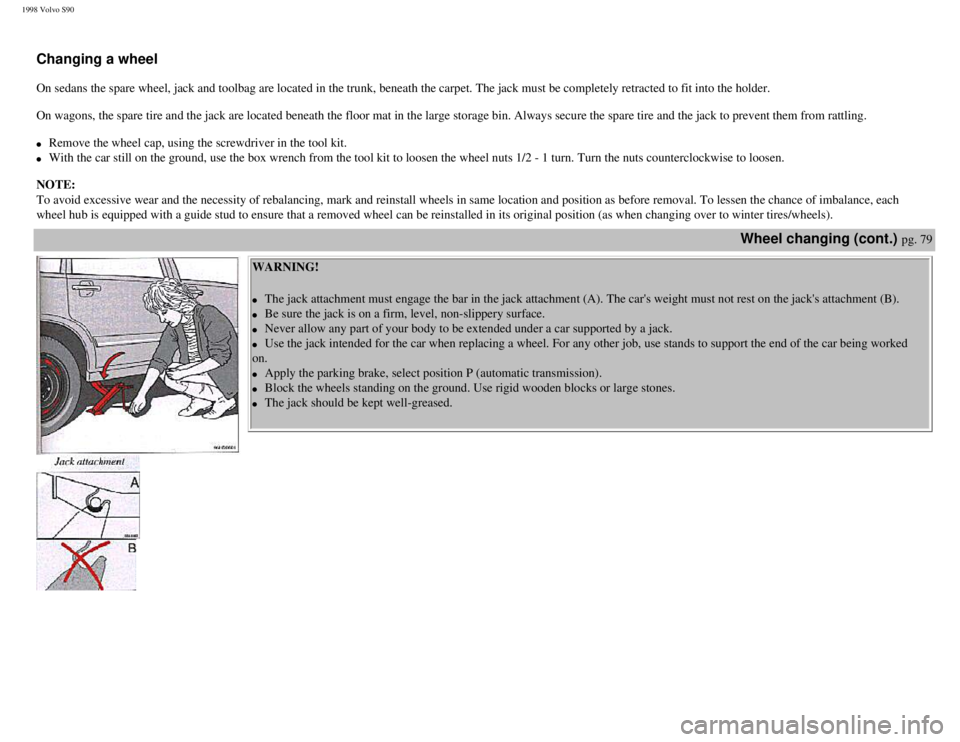
1998 Volvo S90
Changing a wheel
On sedans the spare wheel, jack and toolbag are located in the trunk, be\
neath the carpet. The jack must be completely retracted to fit into the holder.
On wagons, the spare tire and the jack are located beneath the floor mat\
in the large storage bin. Always secure the spare tire and the jack to prevent them from rattling.
l Remove the wheel cap, using the screwdriver in the tool kit.
l With the car still on the ground, use the box wrench from the tool kit t\
o loosen the wheel nuts 1/2 - 1 turn. Turn the nuts counterclockwise to loosen.
NOTE:
To avoid excessive wear and the necessity of rebalancing, mark and reins\
tall wheels in same location and position as before removal. To lessen the chance of imbalance, each
wheel hub is equipped with a guide stud to ensure that a removed wheel c\
an be reinstalled in its original position (as when changing over to winter tires/wheels).
Wheel changing (cont.) pg. 79
WARNING!
l The jack attachment must engage the bar in the jack attachment (A). Th\
e car's weight must not rest on the jack's attachment (B).
l Be sure the jack is on a firm, level, non-slippery surface.
l Never allow any part of your body to be extended under a car supported b\
y a jack.
l Use the jack intended for the car when replacing a wheel. For any other \
job, use stands to support the end of the car being worked
on.
l Apply the parking brake, select position P (automatic transmission). \
l Block the wheels standing on the ground. Use rigid wooden blocks or larg\
e stones.
l The jack should be kept well-greased.
file:///K|/ownersdocs/1998/1998_SV90/98S90_077.htm (2 of 4)12/30/2006 \
1:52:45 PM
Page 89 of 175
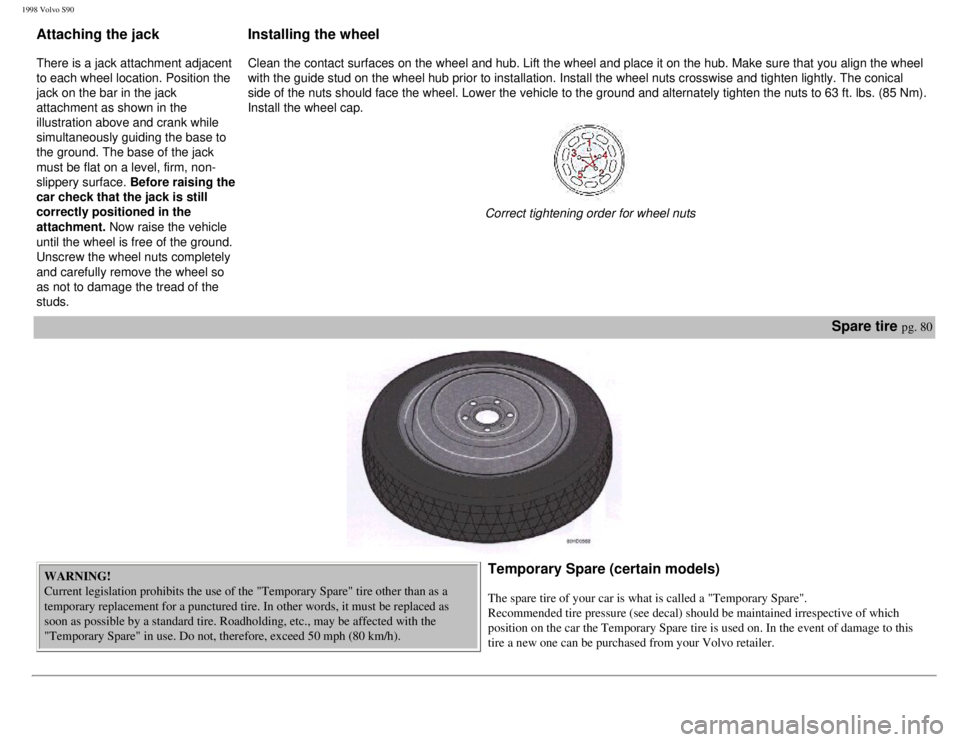
1998 Volvo S90
Attaching the jack
There is a jack attachment adjacent
to each wheel location. Position the
jack on the bar in the jack
attachment as shown in the
illustration above and crank while
simultaneously guiding the base to
the ground. The base of the jack
must be flat on a level, firm, non-
slippery surface. Before raising the
car check that the jack is still
correctly positioned in the
attachment. Now raise the vehicle
until the wheel is free of the ground.
Unscrew the wheel nuts completely
and carefully remove the wheel so
as not to damage the tread of the
studs. Installing the wheel
Clean the contact surfaces on the wheel and hub. Lift the wheel and plac\
e it on the hub. Make sure that you align the wheel
with the guide stud on the wheel hub prior to installation. Install the \
wheel nuts crosswise and tighten lightly. The conical
side of the nuts should face the wheel. Lower the vehicle to the ground \
and alternately tighten the nuts to 63 ft. lbs. (85 Nm).
Install the wheel cap.
Correct tightening order for wheel nuts
Spare tire pg. 80
WARNING!
Current legislation prohibits the use of the "Temporary Spare" tire othe\
r than as a
temporary replacement for a punctured tire. In other words, it must be r\
eplaced as
soon as possible by a standard tire. Roadholding, etc., may be affected \
with the
"Temporary Spare" in use. Do not, therefore, exceed 50 mph (80 km/h). \
Temporary Spare (certain models)
The spare tire of your car is what is called a "Temporary Spare".
Recommended tire pressure (see decal) should be maintained irrespectiv\
e of which
position on the car the Temporary Spare tire is used on. In the event of\
damage to this
tire a new one can be purchased from your Volvo retailer.
file:///K|/ownersdocs/1998/1998_SV90/98S90_077.htm (3 of 4)12/30/2006 \
1:52:45 PM
Page 109 of 175
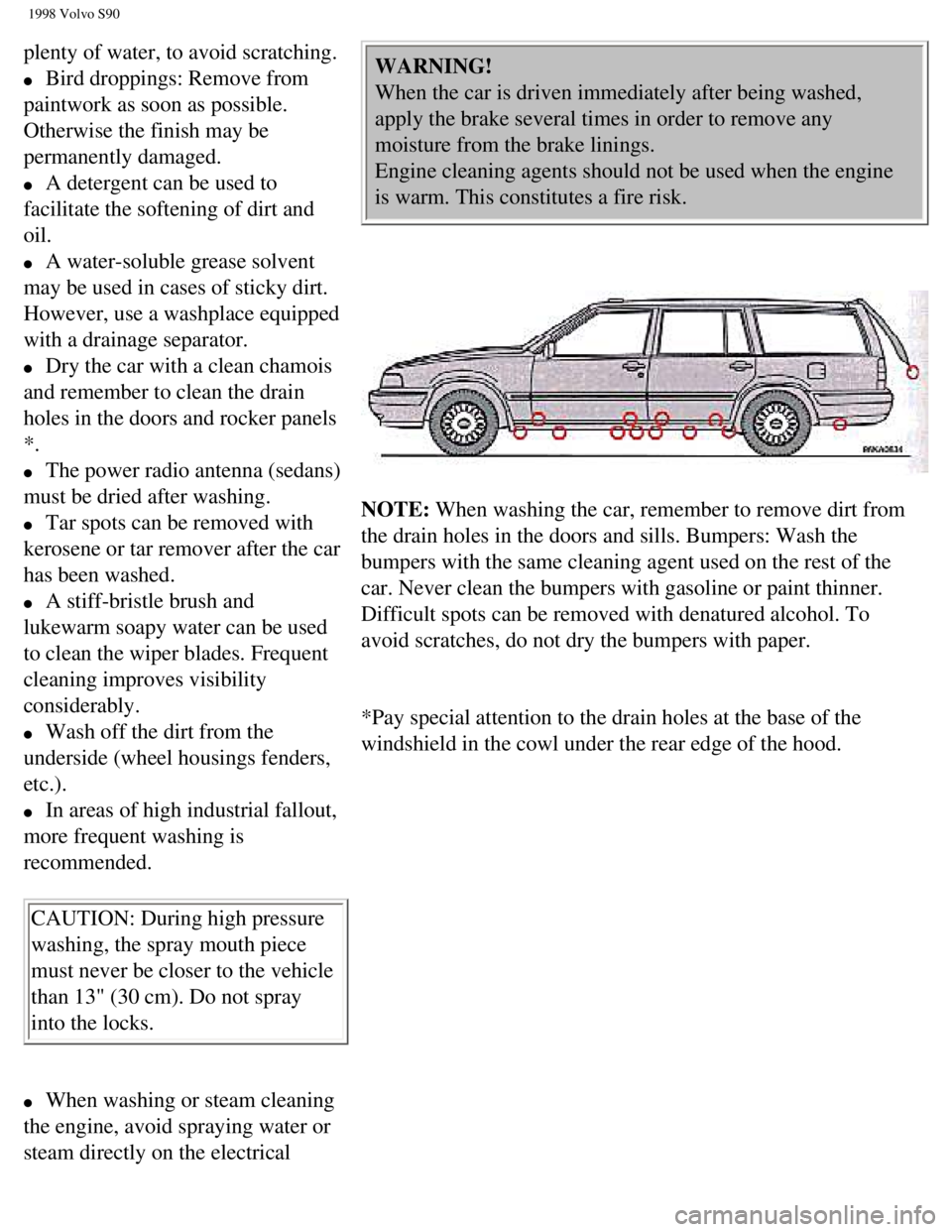
1998 Volvo S90
plenty of water, to avoid scratching.
l Bird droppings: Remove from
paintwork as soon as possible.
Otherwise the finish may be
permanently damaged.
l A detergent can be used to
facilitate the softening of dirt and
oil.
l A water-soluble grease solvent
may be used in cases of sticky dirt.
However, use a washplace equipped
with a drainage separator.
l Dry the car with a clean chamois
and remember to clean the drain
holes in the doors and rocker panels
*.
l The power radio antenna (sedans)
must be dried after washing.
l Tar spots can be removed with
kerosene or tar remover after the car
has been washed.
l A stiff-bristle brush and
lukewarm soapy water can be used
to clean the wiper blades. Frequent
cleaning improves visibility
considerably.
l Wash off the dirt from the
underside (wheel housings fenders,
etc.).
l In areas of high industrial fallout,
more frequent washing is
recommended.
CAUTION: During high pressure
washing, the spray mouth piece
must never be closer to the vehicle
than 13" (30 cm). Do not spray
into the locks.
l When washing or steam cleaning
the engine, avoid spraying water or
steam directly on the electrical
WARNING!
When the car is driven immediately after being washed,
apply the brake several times in order to remove any
moisture from the brake linings.
Engine cleaning agents should not be used when the engine
is warm. This constitutes a fire risk.
NOTE: When washing the car, remember to remove dirt from
the drain holes in the doors and sills. Bumpers: Wash the
bumpers with the same cleaning agent used on the rest of the
car. Never clean the bumpers with gasoline or paint thinner.
Difficult spots can be removed with denatured alcohol. To
avoid scratches, do not dry the bumpers with paper.
*Pay special attention to the drain holes at the base of the
windshield in the cowl under the rear edge of the hood.
file:///K|/ownersdocs/1998/1998_SV90/98S90_097.htm (4 of 6)12/30/2006 \
1:52:47 PM
Page 113 of 175

1998 Volvo S90
Control
Information
Your Volvo
is designed to
meet all
applicable
emissions
standards, as
evidenced by
the
certification
label on the
left
wheelhousing.
For further
information
regarding
these
regulations,
please
consult your
Volvo
retailer.
3 Model
Plate
Vehicle
Identification
Number
(VIN). Codes
for color and
upholstery
etc. This
plate is
located on
panel-above
right
headlight.
4 Loads and
Tire
Pressures
Located on
the rear edge
Location of Labels Illustration
*The Vehicle Identification Number (VIN) should always be quoted in al\
l
correspondence concerning your vehicle with the retailer and when orderi\
ng parts.
All specifications are subject to change without notice.
file:///K|/ownersdocs/1998/1998_SV90/98S90_103.htm (2 of 7)12/30/2006 \
1:52:48 PM
Page 134 of 175

1998 Volvo S90
Chapter 9 - (cont.)
Specifications
pg. 125
Power transmission
Automatic transmission:
Reduction ratios: / AW 40
1st gear / 2.80:1
2nd gear / 1.53:1
3rd gear / 1:1
Overdrive / 0.71:1
Reverse / 2.39:1
Rear axle:
Reduction ratio / 3.73:1
All specifications are subject to change without
notice. Front suspension
McPherson-type spring and strut suspension.
Shock absorbers housed in strut casing. Rack-and-
pinion steering.
Safety-type steering column.
The alignment specifications apply to an unladen
car, but include fuel, coolant, and spare wheel.
Toe-in, measured on the wheel rim: 2.2 mm +/-
1.0 mm (15" wheels)
wheel rim: 2.3 mm +/- 1.0 mm (16" wheels)
tire sides: 2.8 +/- 1.3 mm
Rear Suspension
Multi-link rear wheel suspension consisting of
four elements per side: a trailing support arm with
load leveling shock absorber ("Nivomat" level-
regulating system on certain models), an upper L-
shaped link, a lower traverse link, and an angled
rear track rod to control wheel toe-in.
Toe-in, measured at the wheel rim: (0.4+/- 0.5
mm)
tire sides: (0.5+/- 0.8mm)
Specifications pg. 126
file:///K|/ownersdocs/1998/1998_SV90/98S90_125.htm (1 of 7)12/30/2006 \
1:52:51 PM
Page 138 of 175
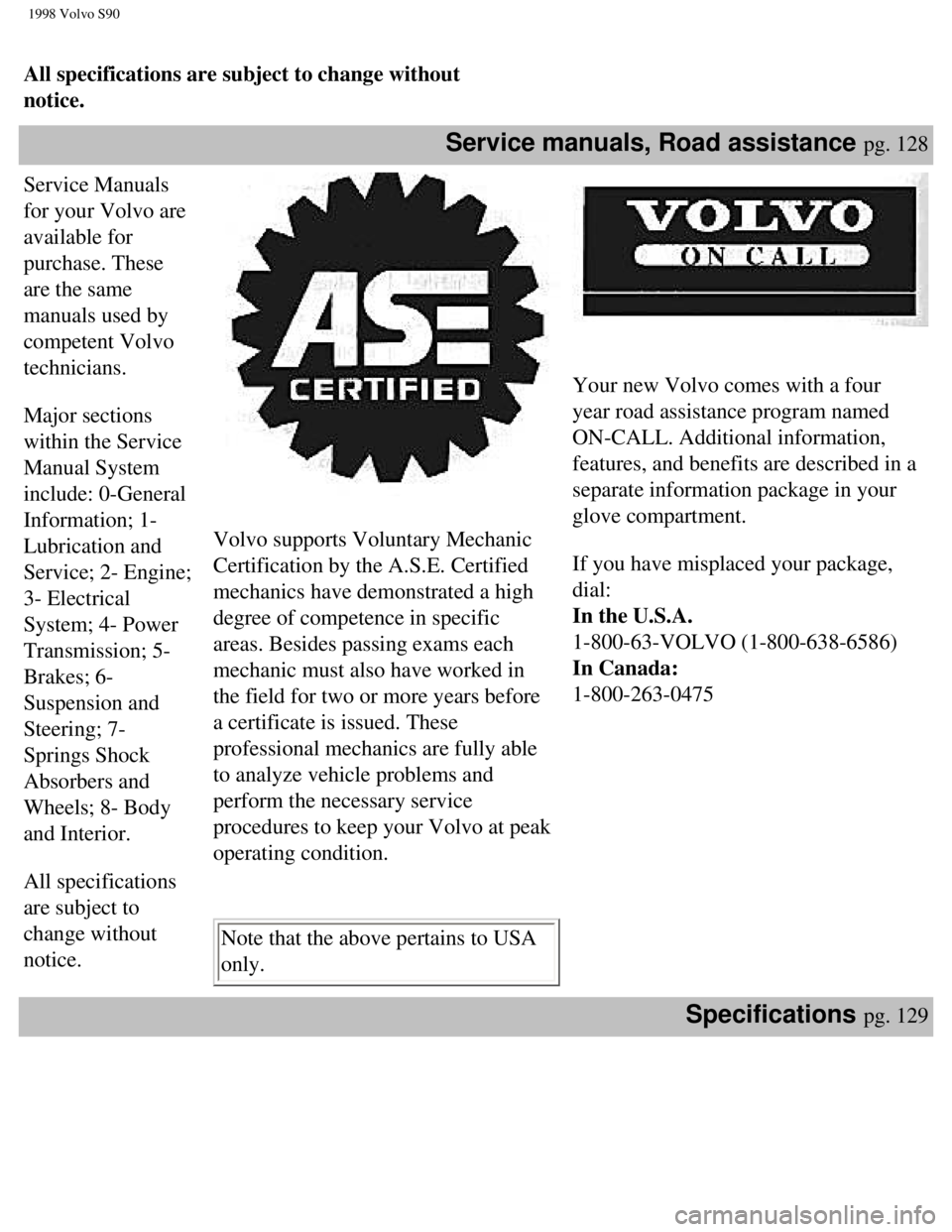
1998 Volvo S90
All specifications are subject to change without
notice.
Service manuals, Road assistance pg. 128
Service Manuals
for your Volvo are
available for
purchase. These
are the same
manuals used by
competent Volvo
technicians.
Major sections
within the Service
Manual System
include: 0-General
Information; 1-
Lubrication and
Service; 2- Engine;
3- Electrical
System; 4- Power
Transmission; 5-
Brakes; 6-
Suspension and
Steering; 7-
Springs Shock
Absorbers and
Wheels; 8- Body
and Interior.
All specifications
are subject to
change without
notice.
Volvo supports Voluntary Mechanic
Certification by the A.S.E. Certified
mechanics have demonstrated a high
degree of competence in specific
areas. Besides passing exams each
mechanic must also have worked in
the field for two or more years before
a certificate is issued. These
professional mechanics are fully able
to analyze vehicle problems and
perform the necessary service
procedures to keep your Volvo at peak
operating condition.
Note that the above pertains to USA
only.
Your new Volvo comes with a four
year road assistance program named
ON-CALL. Additional information,
features, and benefits are described in a
separate information package in your
glove compartment.
If you have misplaced your package,
dial:
In the U.S.A.
1-800-63-VOLVO (1-800-638-6586)
In Canada:
1-800-263-0475
Specifications pg. 129
file:///K|/ownersdocs/1998/1998_SV90/98S90_125.htm (5 of 7)12/30/2006 \
1:52:51 PM
Page 139 of 175
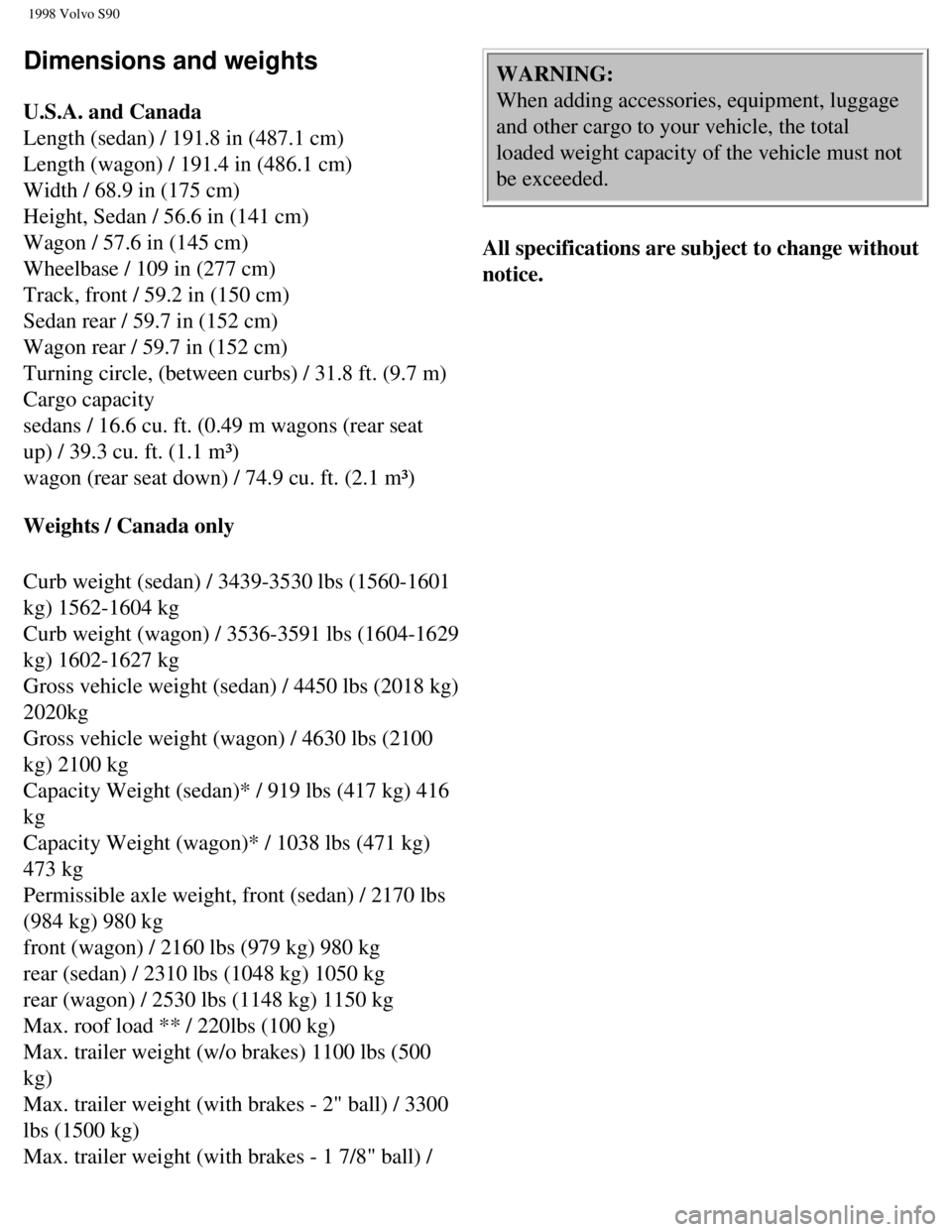
1998 Volvo S90
Dimensions and weights
U.S.A. and Canada
Length (sedan) / 191.8 in (487.1 cm)
Length (wagon) / 191.4 in (486.1 cm)
Width / 68.9 in (175 cm)
Height, Sedan / 56.6 in (141 cm)
Wagon / 57.6 in (145 cm)
Wheelbase / 109 in (277 cm)
Track, front / 59.2 in (150 cm)
Sedan rear / 59.7 in (152 cm)
Wagon rear / 59.7 in (152 cm)
Turning circle, (between curbs) / 31.8 ft. (9.7 m)
Cargo capacity
sedans / 16.6 cu. ft. (0.49 m wagons (rear seat
up) / 39.3 cu. ft. (1.1 m³)
wagon (rear seat down) / 74.9 cu. ft. (2.1 m³)
Weights / Canada only
Curb weight (sedan) / 3439-3530 lbs (1560-1601
kg) 1562-1604 kg
Curb weight (wagon) / 3536-3591 lbs (1604-1629
kg) 1602-1627 kg
Gross vehicle weight (sedan) / 4450 lbs (2018 kg)
2020kg
Gross vehicle weight (wagon) / 4630 lbs (2100
kg) 2100 kg
Capacity Weight (sedan)* / 919 lbs (417 kg) 416
kg
Capacity Weight (wagon)* / 1038 lbs (471 kg)
473 kg
Permissible axle weight, front (sedan) / 2170 lbs
(984 kg) 980 kg
front (wagon) / 2160 lbs (979 kg) 980 kg
rear (sedan) / 2310 lbs (1048 kg) 1050 kg
rear (wagon) / 2530 lbs (1148 kg) 1150 kg
Max. roof load ** / 220lbs (100 kg)
Max. trailer weight (w/o brakes) 1100 lbs (500
kg)
Max. trailer weight (with brakes - 2" ball) / 3300
lbs (1500 kg)
Max. trailer weight (with brakes - 1 7/8" ball) / WARNING:
When adding accessories, equipment, luggage
and other cargo to your vehicle, the total
loaded weight capacity of the vehicle must not
be exceeded.
All specifications are subject to change without
notice.
file:///K|/ownersdocs/1998/1998_SV90/98S90_125.htm (6 of 7)12/30/2006 \
1:52:51 PM